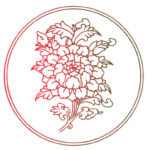
Reports From The Mandala
Head Lama of TNMC
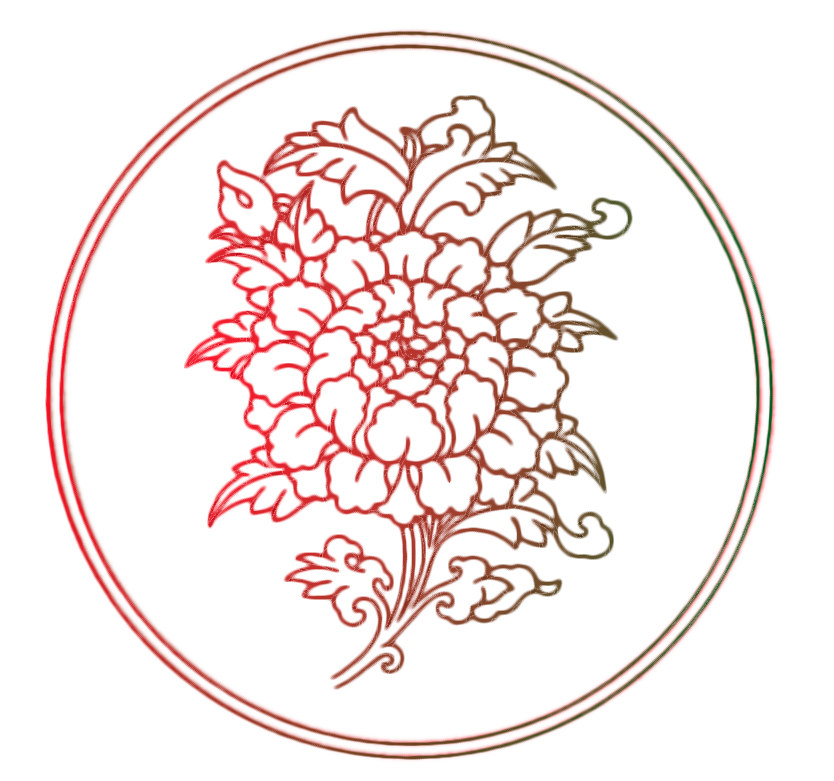
The International Mandala
Over the past decade, the Nyingma Mandala of Organizations has expanded dramatically and in unexpected ways. Existing organizations have continued their activities on behalf of the Dharma and all sentient beings, typically intensifying their efforts. At the same time, at least nine new organizations have been formed, adding new dimensions to the founding Head Lama’s vision.
In the report that follows, we lay out recent developments throughout the mandala and introduce the work of our new organizations. We start with the work of TNMC, where the Head Lama is most directly involved: Yeshe De, Odiyan, the Light Foundations, and the Sarnath Institute. From there we move on to describe the structure and mission of the Nyingma Association of Mandala Organizations (NAMO), founded in 2011.
We go on to lay out the recent work of the organizations that belong to NAMO. As a structure for presenting this wealth of developments, we start with the organizations located in Sonoma County, then turn to developments in Berkeley, and finally report on the expanding efforts of our international centers, under the direction of Nyingma Centers.
By the mid-1980s, students from abroad who had attended classes at the Nyingma Institute in Berkeley had formed study groups in several countries. At first these groups mostly invited teachers from the Institute, but gradually they became interested in establishing their own centers and training their own teachers
Starting in 1989, Rinpoche took an active role in directing the growth of the four groups— two in Brazil and one each in Germany and Holland—who had demonstrated the greatest interest. He gave Nyingma Centers responsibility for guiding their development, following guidelines that he established. This process unfolded at different speed at each of the four new centers, but during the 1990s each was officially authorized by the Head Lama.
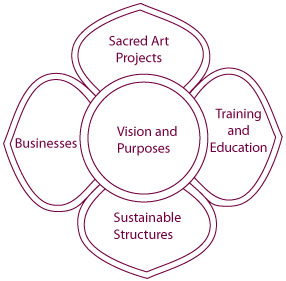
The reports here start with Nyingma Centers, which contains to have primary responsibility for directing the four international centers, and then goes on to present a brief overview of what is happening at each center. A fifth study group that started in Argentina in the 1990s was officially recognized as a center at the beginning of 2013. The Argentine center has been very active in teaching, art projects, and publishing, but until now it has not been fully integrated into the mandala structure, so it is not included in this report.
More From This Issue

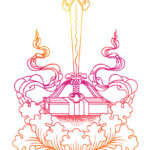
Reports from the Mandala Yeshe De Project
Reports From The Mandala Head Lama of TNMC Over the
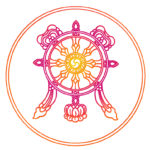
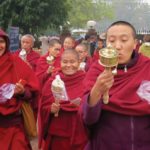
Reports from the Mandala Ritual Art
Reports From The Mandala Head Lama of TNMC Grateful recipients
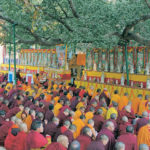
Reports from the Mandala World Peace Ceremony
Reports From The Mandala Head Lama of TNMC Over the
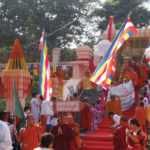
Reports from the Mandala Light Foundations
Reports From The Mandala Head Lama of TNMC Monks enter
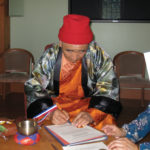
Nyingma Association of Mandala Oragnizations
Reports From The Mandala Head Lama of TNMC Tarthang Rinpoche

Reports Mandala of Organizations in Sonoma Dharma Publishing
Reports From The Mandala Head Lama of TNMC Over the
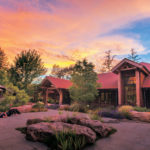
Reports Mandala of Organizations in Sonoma Ratna Ling
Reports From The Mandala Head Lama of TNMC The plaza
The International Mandala (continued)
Centro Nyingma do Brasil
The Center in São Paulo started functioning informally as an institute for study and practice in 1984. In 1986, it was formally established as a non-profit religious corporation, Instituto Nyingma do Brasil. The Instituto operated in a rented location until 2008, when it bought its own house, named Casa do Mandala. Currently no one lives at the Casa do Mandala, but we hope that will change soon. The name of the center is being changed to “Centro Nyingma do Brasil” in connection with adopting new bylaws.
In 1996, Gráfica do Dharma started operations as a for-profit business, in order to provide a source of financial stability. It moved several times as its operations expanded. The press did well in the
field of transfer sublimation, and now owns and operates five Heidelberg presses; it is one of the leading business of its kind in Brazil. In the past two years there have been extensive changes in the management structure of GD, leading to some instability, but it seems that operations are once again proceeding smoothly.
Gráfica’s printing operation is well-suited to printing prayer flags, and this has become a major ongoing project, with tens of thousands of pray flags printed. The process starts with the image of the flag being transferred to paper at Gráfica do Dharma, using their specialized presses. Volunteers then come in after business hours and use transfer machines to make the printed flags, which are then taken to the Casa da Mandala to sew, heat-seal, and string onto long cords. In one project, members of CNB took about a hundred flags into the mountains that surround São Paulo and hung them in the trees of the forest.
In 2010–12, CNB took on a major project at Rinpoche’s request: printing a complete edition of the Tog Palace Kanjur, (a manuscript version of the Kanjur that had only come to light in recent years). In order to carry out this project, CNB had to rent a building and by a new perfecter press, since the presses at Gráfica do Dharma were not set up for this kind of printing. The printed books were sent to the center in Rio de Janeiro for binding, and from there sent to India.
Like the other centers, CNB is currently making 2,500 tsa-tsas. In addition, volunteers cast the eight auspicious symbols in plaster, an ongoing project within the mandala. CNB also recently took on a special project at Rinpoche’s request: producing 108 Padmasambhava statues (The other centers are making smaller numbers.) The statues are made by professionals, but the finish work is done by volunteers at CNB. Rinpoche has made 10–20 of these statues available as gifts to major donors, the first time he has allowed the statues made within the community to be available for such a purpose.
Associação Cultural do Grupo Nyingma do Rio de Janeiro
The Rio Center has been in operation since 1987, and formally came into existence in 1994. It will change its structure in 2014 to become a religious organization, and will change its name to Centro Nyingma de Budismo Tibetano. Its building was acquired in 1994. In 2013 the Center incorporated a separate business to engage in import and export, but it has not yet started operations.
The Rio center has cooperated with the center in São Paulo in various projects in the past several years. During production of the Tog Palace Kanjur, it rented a facility to use as a bindery, assembling, edge dyeing, and wrapping each volume before packing it for shipment.
Rio also makes prayer flags, using transfer paper sent to it by Gráfica do Dharma. Recently they were able to work with the government to hang prayer flags from the trees surrounding a city lake.
For many years, the Rio center has had held ceremonies that attract large numbers. It holds chanting ceremonies five times a month, on the four ceremony days and a fifth chant for the Medicine Buddha. There are almost always more than a hundred people in attendance.
Rio also has three strong branches. More than study groups, these branches, in Porto Alegre, Brasilia, and Curitaba, have projects and shops and are very active. The group in Porto Alegre, which has some twenty stable members, has bought a 3,000 sq. ft. parcel of land and plans to build its own center. The main center in Rio is actively involved with the centers, traveling to each of them regularly and offering regular guidance.
The building in which the Rio Center is located is beautfully situated, on a hill directly facing Corcovado Mountain, with its world-famous statue of Christ the Redeemer. Recently, in a major change, the center closed down a swimming pool on the property and moved its stupa to that new location, creating a garden to surround it. It is now greets each visitor who enters the Center.
Nyingma Centrum Nederland
Holland operates through two non-profit organizations: Stichting Nyingma Centrum Nederland (NCN), established in 1984, and Stichting Nyingma Project (NPN), established in 1989.
In recent years, the Institute has experienced major changes, both in terms of its growing number of students and in terms of its physical plant. The store was extensively renovated and is thriving; members of the Centrum travel regularly to Nepal to purchase items for sale. The third and fourth floors of the Centrum were completely renovated as well.
The Centrum oversees the operation of six strong and stable study groups. Teachers travel to each group monthly to help develop their programs.
From 2012–14, recognizing the need for a new generation of leaders, the Dutch Center worked with Nyingma Centers as on a pilot project for training new leaders in accord with mandala principles. This program has proved very successful: seven people have completed the program and are now moving into positions of greater responsibility.
In terms of educational programs, the Dutch center has been the only one of the centers to maintain consistent programs in the Time, Space, and Knowledge vision. Now that the vision is becoming one of the eight departments in each center, we look forward to working with the other centers to expand the reach and availability of these teachings.
Nyingma Zentrum Deutschland
Nyingma Zentrum Deutschland was established in 1983 in the city of Münster. Its founders had a strong background in therapy, and their first contact with Nyingma was through Dutch therapists who had visited the Institute in Berkeley. The focus initially was on the practice of Kum Nye, and indeed the Kum Nye books sold very well in Germany, even being issued as mass-market paperbacks.
The center soon began working on art projects. In 1994 it established a commercial press, Dharma Druckund Vertriebs Verlag, which continued as a succesful business until the center moved from Münster to Köln in 2002.
During these years Lotus Design was also established (its first small beginnings actually date to 1986). Lotus Design focused first on meditation cushions but now offers a much wider range of products, operating at both the retail and wholesale level. It now has a branch in London and handles wholesale operations in Holland as well. It has begun working with the Sarnath Institute, which supplies it with meditation cushions.
Between 2010–12, the whole house was substantially renovated, with volunteers assisting a professional crew. The renovation was funded through a major fund-raing effort, assisted by a bank that specializes in making low-interest loans to non-profit organizations.
As part of this renovation, the Öm café was established on the ground floor of the building, in the former meditation room. Opened in 2013, it has been established as its own for-profit corporation.